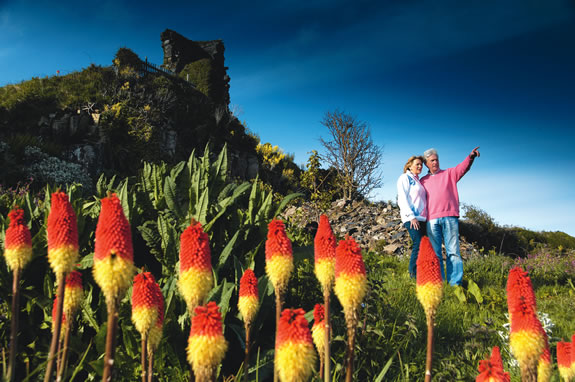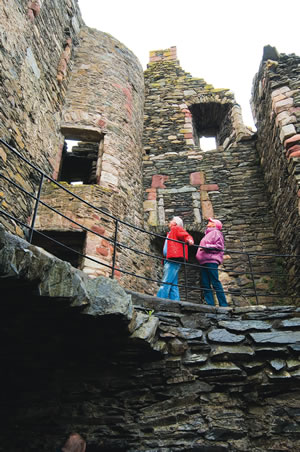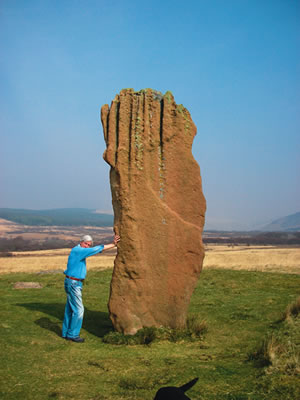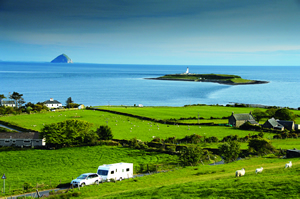
Christine and Alisdair Lyle cross the Firth of Clyde to explore a thrilling island
The Isle of Arran lies in the Firth of Clyde alongside the Mull of Kintyre and, although it measures only some 19 miles long by 10 miles wide, it truly lives up to its title of ‘Scotland in miniature’. From the mountainous north down to the pastoral south, the island is a hive of activity.

Reaching Arran is easy. Caledonian MacBrayne (CalMac) runs a regular service from Ardrossan on the mainland to Brodick on the island. You can look up the times of sailings on www.calmac.co.uk or phone 08705 650 000 to make your reservation. They are always very helpful.
Arran has a history that dates back as far as the Stone Age, perhaps as far back as 7000 BC. It was part of the Kingdom of Dalriada and its Gaelic-speaking people were ruled by Ireland. Christianity arrived on the island in the 6th century and through the years the Vikings, the Celts, the English and the Stewart and MacDonald clans have all ruled here. Robert the Bruce also left his mark. So all this history has left a trail worthy of exploration.
Here is Heaven on Earth! A wonderful setting in a spectacular …
Park set in Cordon - stunning location in the village of Lamlash …
If you are looking for a quiet and relaxing holiday, Carradale …
The island’s population has varied over the years and, like many areas of Scotland, has suffered through the Highland clearances. Today, there’s a permanent population of around 5000, but that number swells in the summertime due to the popularity of the island as a holiday destination.
We first got to know the island well by sailing around it and dropping our anchor in every welcoming bay; now we were keen to explore inland. We chose to stay at a site in Kildonan, the Seal Shore Camping & Touring Site, which is at the very southern tip of the island looking south over the Pladda lighthouse and Ailsa Craig. When visibility is clear, you can actually see Ireland on the horizon and, looking west, the Mull of Kintyre. The island of Ailsa Craig (or Paddy’s Milestone) was the main source of granite for manufacturing curling stones and quarrying for the stone was a very dangerous occupation at the time. Now the rocks are home to many sea bird colonies.
As you come off the ferry after the 55-minute crossing, turn left on the main road and travel 12 miles south to the first sign for Kildonan and the Seal Shore Camping and Touring site. You’ll see the site on your left as you approach. Turn left at the white brick wall and you’re there. To one side there are the remains of a medieval castle, but below the site is a lovely sandy beach. Our two dogs loved snuffling along the seashore. If you get lucky you might spot an otter, but certainly the seals can be seen lounging around on the rocks. We found, along with other campers, that on some days it was enough just to sit and take in the peace and tranquillity and not rush to do anything.
 As you drive around, you can’t help but marvel at the variety of sights
As you drive around, you can’t help but marvel at the variety of sightsTaking the road from Kildonan to Blackwaterfoot, one of the bumpiest I think I’ve ever been on, you will pass Arran Dairies. We didn’t stop to look around the creamery, but we have tasted its ice cream. Made with double cream and fresh milk, all produced on the island, it is fabulous. Just to the north of Blackwaterfoot and on the left-hand side of the road is the car park and the start of the walk to the King’s Cave. It is said that Robert the Bruce hid in these caves from the English, watching the little spider that fell from its web, only to climb back time and again. This prompted Robert to renew his struggle with the English and to tell his army “If at first you don’t succeed, try, try again” – or so the story goes. It’s a walk of about five miles in total, first along a hillside with lovely views over Machrie Moor and up to Goat Fell and over the water to Kintyre. The path takes you down the cliffside to the caves where there are early Christian carvings and suggestions of Viking habitation. The path then leads you back up the cliffside and down through the woods to the car park.
Back on the road and just a couple of miles along, there’s a small parking area on the left of the road and on the right is the start of the footpath onto Machrie Moor and the Standing Stones. About one mile along the path are six stone circles within a short distance of each other. The exact purpose of these stones is unknown, but they could be around 5000 years old. We stood in the middle of the stone circle trying to imagine what they were built for and why.
Continuing back on the road, heading north to Lochranza, we passed through Pirnmill and Catacol. In Catacol you will see the row of 12 almost identical cottages known as the ‘Twelve Apostles’. These cottages were built to house the islanders cleared from Glen Catacol in favour of deer, which at the time were more profitable than sheep.
Further on, Lochranza lies on a beautiful bay with the castle standing proud on a spit of land. It was probably built around the middle of the 13th century, but its full history is somewhat sketchy. We always see red deer roaming free here, seemingly oblivious to our presence. Lochranza is also home to the Isle of Arran Distillery, the only distillery on the island, so make time to stop for a wee dram. Several malt whiskies are available along with their flagship, ten-year-old single malt, the ‘Arran Malt’. You should also try ‘Arran Gold’, a liqueur made from fresh cream and ‘Arran Malt’.
 The Standing Stones on Machrie Moor are prehistoric, but we’re not sure about Alisdair...
The Standing Stones on Machrie Moor are prehistoric, but we’re not sure about Alisdair... From Lochranza, during the summer months only, it is possible to take a car ferry over to Skipness on the Kintyre peninsular. The longest golf course on the island is also here in Lochranza and adjacent is Lochranza Caravan & Camping site – an ideal site if you like golf.
Turning south-east now and on the way to Brodick, we pass through the hills and see Goat Fell, the highest point on the island. Although not a Munro (a hill of 3000 feet and over), at 2868 feet it provides a challenge and many serious hill walkers do like to bag this one. There are two routes to the top and details can be obtained from the Tourist Information Centre in Brodick. We just had to stop in the village of Corrie to see its delightful little harbour. Did you know that Corrie was the birthplace of the book publisher Daniel Macmillan?
The next point to visit is Brodick Castle. Strictly speaking, this is not a castle but a fortified house. It lies in beautiful gardens, which are worth a visit alone. Brodick Castle is the seat of the Dukes of Hamilton, although the property now belongs to the National Trust for Scotland. We had a most wonderful time wandering around the house. In each room there is a guide who can explain all its historical artefacts – no mean task, let me tell you, because it is rich with furniture, paintings, antiques and decorations fit for any castle. Allow yourself plenty of time to do this one.
Within what used to be the Home Farm to the castle is the Island Cheese Company. Here they produce the famous wax-sealed flavoured cheddars and I strongly suggest you try them – delicious. Also close by is the Isle of Arran Brewery, which produces a popular range of beers slowly becoming available throughout the UK mainland. Just to finish off is the home of Arran Aromatics, a shop full of lovely smelly things – just what we girls enjoy. Brodick itself is the main port for the island and is a busy bustling place.
It has a good range of shops, supermarkets, hotels, lots of places to eat, banks, a post office, a tourist information centre and a lovely shop that sells only chocolate.
 Crossing the Firth of Clyde to explore a thrilling island
Crossing the Firth of Clyde to explore a thrilling island We came over the hill into Lamlash, a very popular spot for boating. This is the largest village on the island and faces Holy Island. Boat trips can be taken to Holy Island to see the monastery, which is owned by Tibetan monks and is still used as a spiritual retreat. Lamlash is also home to Arran Fine Foods, which produces a good range of mustards, relishes, chutneys, marmalades and preserves.
On the last part of the journey we passed through Whiting Bay, where we found the Eden Lodge Hotel: we sat out on the terrace to enjoy our bar meal, lovely fresh scampi, and take in yet another stunning sea view.
As you drive around the island, you cannot help but marvel at the variety of sights. Seascapes and landscapes flood in at every turn. But take your time to stop and look. There are no grey squirrels on Arran, so the rare pretty little red squirrels have a healthy population here – just keep a lookout. Red deer abound, along with red grouse and black grouse, and even ptarmigan have been seen. There is a number of wetland species resident on Arran, such as heron, mallard, shelduck, merganser and eider. Up in the mountains it’s possible to see buzzards, peregrines, kestrels, hen harriers, sparrow hawks and, very occasionally, golden eagles. Look out to sea and see if you can spot seals, porpoises, basking sharks and even dolphins.
If golf is your thing, there are no less than seven courses on the island, with a combination of links, parkland and heathland, nine and 18 holes. You could buy an Arran Golf Pass that will entitle you to a round on each course. Or you could try paragliding; take a helicopter ride; have a boat trip; go pony trekking, rock climbing or quad biking; try archery, fishing or cycling. There is so much to choose from and so little time…
Christine and Alisdair Lyle cross the Firth of Clyde to explore a thrilling island
The Isle of Arran lies in the Firth of Clyde alongside the Mull of Kintyre and, although it measures only some 19 miles long by 10 miles wide, it truly lives up to its title of ‘Scotland in miniature’. From the mountainous north down to the pastoral south, the island is a hive of activity.

Reaching Arran is easy. Caledonian MacBrayne (CalMac) runs a regular service from Ardrossan on the mainland to Brodick on the island. You can look up the times of sailings on www.calmac.co.uk or phone 08705 650 000 to make your reservation. They are always very helpful.
Arran has a history that dates back as far as the Stone Age, perhaps as far back as 7000 BC. It was part of the Kingdom of Dalriada and its Gaelic-speaking people were ruled by Ireland. Christianity arrived on the island in the 6th century and through the years the Vikings, the Celts, the English and the Stewart and MacDonald clans have all ruled here. Robert the Bruce also left his mark. So all this history has left a trail worthy of exploration.
Here is Heaven on Earth! A wonderful setting in a spectacular …
Park set in Cordon - stunning location in the village of Lamlash …
If you are looking for a quiet and relaxing holiday, Carradale …
The island’s population has varied over the years and, like many areas of Scotland, has suffered through the Highland clearances. Today, there’s a permanent population of around 5000, but that number swells in the summertime due to the popularity of the island as a holiday destination.
We first got to know the island well by sailing around it and dropping our anchor in every welcoming bay; now we were keen to explore inland. We chose to stay at a site in Kildonan, the Seal Shore Camping & Touring Site, which is at the very southern tip of the island looking south over the Pladda lighthouse and Ailsa Craig. When visibility is clear, you can actually see Ireland on the horizon and, looking west, the Mull of Kintyre. The island of Ailsa Craig (or Paddy’s Milestone) was the main source of granite for manufacturing curling stones and quarrying for the stone was a very dangerous occupation at the time. Now the rocks are home to many sea bird colonies.
As you come off the ferry after the 55-minute crossing, turn left on the main road and travel 12 miles south to the first sign for Kildonan and the Seal Shore Camping and Touring site. You’ll see the site on your left as you approach. Turn left at the white brick wall and you’re there. To one side there are the remains of a medieval castle, but below the site is a lovely sandy beach. Our two dogs loved snuffling along the seashore. If you get lucky you might spot an otter, but certainly the seals can be seen lounging around on the rocks. We found, along with other campers, that on some days it was enough just to sit and take in the peace and tranquillity and not rush to do anything.
 As you drive around, you can’t help but marvel at the variety of sights
As you drive around, you can’t help but marvel at the variety of sightsTaking the road from Kildonan to Blackwaterfoot, one of the bumpiest I think I’ve ever been on, you will pass Arran Dairies. We didn’t stop to look around the creamery, but we have tasted its ice cream. Made with double cream and fresh milk, all produced on the island, it is fabulous. Just to the north of Blackwaterfoot and on the left-hand side of the road is the car park and the start of the walk to the King’s Cave. It is said that Robert the Bruce hid in these caves from the English, watching the little spider that fell from its web, only to climb back time and again. This prompted Robert to renew his struggle with the English and to tell his army “If at first you don’t succeed, try, try again” – or so the story goes. It’s a walk of about five miles in total, first along a hillside with lovely views over Machrie Moor and up to Goat Fell and over the water to Kintyre. The path takes you down the cliffside to the caves where there are early Christian carvings and suggestions of Viking habitation. The path then leads you back up the cliffside and down through the woods to the car park.
Back on the road and just a couple of miles along, there’s a small parking area on the left of the road and on the right is the start of the footpath onto Machrie Moor and the Standing Stones. About one mile along the path are six stone circles within a short distance of each other. The exact purpose of these stones is unknown, but they could be around 5000 years old. We stood in the middle of the stone circle trying to imagine what they were built for and why.
Continuing back on the road, heading north to Lochranza, we passed through Pirnmill and Catacol. In Catacol you will see the row of 12 almost identical cottages known as the ‘Twelve Apostles’. These cottages were built to house the islanders cleared from Glen Catacol in favour of deer, which at the time were more profitable than sheep.
Further on, Lochranza lies on a beautiful bay with the castle standing proud on a spit of land. It was probably built around the middle of the 13th century, but its full history is somewhat sketchy. We always see red deer roaming free here, seemingly oblivious to our presence. Lochranza is also home to the Isle of Arran Distillery, the only distillery on the island, so make time to stop for a wee dram. Several malt whiskies are available along with their flagship, ten-year-old single malt, the ‘Arran Malt’. You should also try ‘Arran Gold’, a liqueur made from fresh cream and ‘Arran Malt’.
 The Standing Stones on Machrie Moor are prehistoric, but we’re not sure about Alisdair...
The Standing Stones on Machrie Moor are prehistoric, but we’re not sure about Alisdair...From Lochranza, during the summer months only, it is possible to take a car ferry over to Skipness on the Kintyre peninsular. The longest golf course on the island is also here in Lochranza and adjacent is Lochranza Caravan & Camping site – an ideal site if you like golf.
Turning south-east now and on the way to Brodick, we pass through the hills and see Goat Fell, the highest point on the island. Although not a Munro (a hill of 3000 feet and over), at 2868 feet it provides a challenge and many serious hill walkers do like to bag this one. There are two routes to the top and details can be obtained from the Tourist Information Centre in Brodick. We just had to stop in the village of Corrie to see its delightful little harbour. Did you know that Corrie was the birthplace of the book publisher Daniel Macmillan?
The next point to visit is Brodick Castle. Strictly speaking, this is not a castle but a fortified house. It lies in beautiful gardens, which are worth a visit alone. Brodick Castle is the seat of the Dukes of Hamilton, although the property now belongs to the National Trust for Scotland. We had a most wonderful time wandering around the house. In each room there is a guide who can explain all its historical artefacts – no mean task, let me tell you, because it is rich with furniture, paintings, antiques and decorations fit for any castle. Allow yourself plenty of time to do this one.
Within what used to be the Home Farm to the castle is the Island Cheese Company. Here they produce the famous wax-sealed flavoured cheddars and I strongly suggest you try them – delicious. Also close by is the Isle of Arran Brewery, which produces a popular range of beers slowly becoming available throughout the UK mainland. Just to finish off is the home of Arran Aromatics, a shop full of lovely smelly things – just what we girls enjoy. Brodick itself is the main port for the island and is a busy bustling place.
It has a good range of shops, supermarkets, hotels, lots of places to eat, banks, a post office, a tourist information centre and a lovely shop that sells only chocolate.
 Crossing the Firth of Clyde to explore a thrilling island
Crossing the Firth of Clyde to explore a thrilling islandWe came over the hill into Lamlash, a very popular spot for boating. This is the largest village on the island and faces Holy Island. Boat trips can be taken to Holy Island to see the monastery, which is owned by Tibetan monks and is still used as a spiritual retreat. Lamlash is also home to Arran Fine Foods, which produces a good range of mustards, relishes, chutneys, marmalades and preserves.
On the last part of the journey we passed through Whiting Bay, where we found the Eden Lodge Hotel: we sat out on the terrace to enjoy our bar meal, lovely fresh scampi, and take in yet another stunning sea view.
As you drive around the island, you cannot help but marvel at the variety of sights. Seascapes and landscapes flood in at every turn. But take your time to stop and look. There are no grey squirrels on Arran, so the rare pretty little red squirrels have a healthy population here – just keep a lookout. Red deer abound, along with red grouse and black grouse, and even ptarmigan have been seen. There is a number of wetland species resident on Arran, such as heron, mallard, shelduck, merganser and eider. Up in the mountains it’s possible to see buzzards, peregrines, kestrels, hen harriers, sparrow hawks and, very occasionally, golden eagles. Look out to sea and see if you can spot seals, porpoises, basking sharks and even dolphins.
If golf is your thing, there are no less than seven courses on the island, with a combination of links, parkland and heathland, nine and 18 holes. You could buy an Arran Golf Pass that will entitle you to a round on each course. Or you could try paragliding; take a helicopter ride; have a boat trip; go pony trekking, rock climbing or quad biking; try archery, fishing or cycling. There is so much to choose from and so little time…